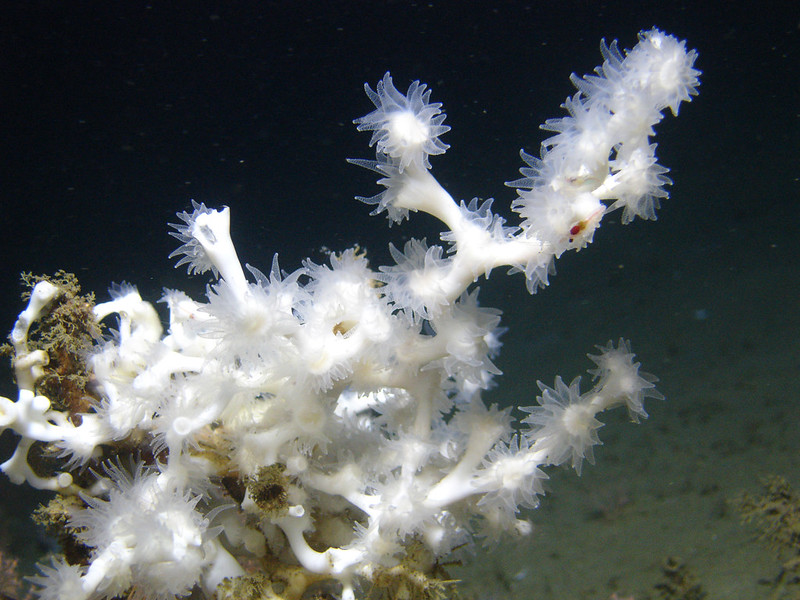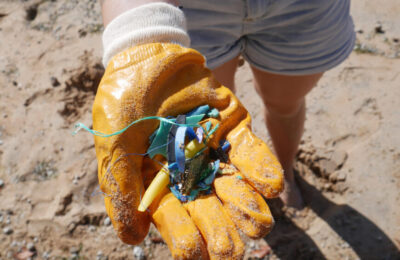Järnegren, J., Brooke, S., & Jensen, H. (2020). Effects and recovery of larvae of the cold-water coral Lophelia pertusa (Desmophyllum pertusum) exposed to suspended bentonite, barite and drill cuttings. Marine Environmental Research,158. doi:10.1016/j.marenvres.2020.104996
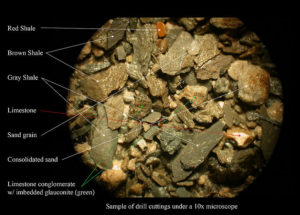
Pressure, pushing down on me
If you were to visit the deep seafloor searching for an oil well under construction, it’s likely you’d see the drill bit pipe expelling plumes of debris. This debris doesn’t only contain sand and rock (drill cuttings) from boring a hole in the seafloor, though. (Fig. 1) It can also have additives in it—minerals and clay (drilling mud) designed to keep drill bits running smoothly—that can contaminate the surrounding waters. In addition to the plumes emerging from the drill bit pipes, oilrigs pump larger amounts of drill cuttings up to the platforms themselves, before processing it and dumping it back overboard. These clouds may be unpleasant as the waters before you grow murkier, obstructing your view of the seafloor’s mysterious realm. For you in your underwater vehicle, losing visibility is a temporary inconvenience. But what about for the organisms that naturally belong here in the deep?
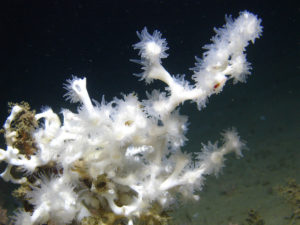
How about cold-water corals? (Fig. 2) These slow-growing, sedentary animals provide habitat for dozens of deep-sea dwellers. We already know if debris plumes from nearby wells bury these adult corals with amounts 5-10 millimeters deep, the corals can’t capture enough food. What about for their larvae, though? The larvae are free-swimming and search up to a month for a patch to settle on. At a mere 0.1 millimeters long, swimming through water clouded by drilling mud has to be a challenge, right? That’s precisely what Johanna Järnegren and her colleagues set off to find out.
To expose larvae to controlled levels of drilling mud, Järnegren’s team collected samples of adult corals that were then spawned back at the lab. The team raised larvae to two ages (eight and 21 days) and then exposed them to different concentrations of three compounds typically found in the drilling contaminants (bentonite, barite, or drill cuttings). Larvae were placed in treatment vials designed like perpetual snow globes, gently rotating around to keep the particles suspended in water. The researchers’ goal was to see if/how many particles stuck to the cilia (hair-like structures) the coral larvae use for swimming. (Fig. 3) More particles sticking to cilia could slow the larvae down, or cause them to form mucus coats for protection. In the wild, this could lead to predation or sinking—neither of which are good things for a slow-growing, delicate species. Afterward, the team moved exposed larvae to clean water for 24 hours to see if they could slough off the particle baggage and swim normally again.
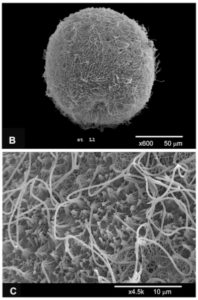
Coming clean…or not?
Of all the compounds, Järnegren’s team found bentonite to be the most troublesome. Even at low concentrations, it stuck to larvae’s protective mucus coating, and with increasing concentrations would fully clog the cilia, weighing it down. Interestingly, at higher concentrations, more eight-day-old larvae survived when compared to the 21-day-old larvae. The older group, on the other hand, bore the brunt: about 30% died. Järnegren found up to half of the larvae died at bentonite concentrations 23-35 times lower than “hazardous” levels calculated a decade ago, suggesting the larvae may be much more sensitive than previously thought.
Barite and drill cuttings, by comparison, posed less of a threat for the larval corals by simply dusting the cilia without restricting movement. Drill cuttings, however, did have some lethal consequences for older, 21-day-old larvae. At the higher concentrations, about 7% did not survive, while about 6% struggled with swimming. Unfortunately, not enough spawned larvae survived for testing the effects of barite on larvae, but the scientists noted future studies should test its effects.
But after all this drill compound dousing, were the surviving larvae able to recover? Encrusted larvae weren’t always successful, but the majority could break out of their particle-laden mucus shells and swim away given 24 hours in clean water. This suggests that with spaced-out exposures, larvae can shake themselves off, increasing their chances of escaping predators and successfully settling to grow the reef.
Washing away the grime
Järnegren’s study is one of the first looking at how early life stages of this fragile, habitat-building species is affected by human activities. The researchers found signs that certain compounds used in drilling are harder for larvae to recover from—if they recover at all. However, we also learned there could be modifications to when we introduce these drilling muds to the environment that could benefit adult corals and their offspring.
New regulations could take current speed, current direction, volume, and time of dumping activity into account, to make sure concentrations of drilling compounds don’t overwhelm these ecosystems. These days, dumping takes place every few hours, so extending the time between—especially during coral spawning seasons—could potentially reduce how much these little larvae have to struggle as they grow and settle. Regulators should consider how larvae recovered in 24 hours in this study.
We humans live at a rapid pace…sometimes we need a little reminder from a larva to pump the breaks and give it some breathing (or in this case, swimming) room.
I am a former PhD student from the University of Rhode Island, having discovered my love of teaching and informal science education in part through OceanBites! Since departing academia, I’ve focused on creating educational content for visitors at the New England Aquarium, Chincoteague Bay Field Station, and now the National Aquarium. I’ve also dabbled in co-creating a comedy/brainstorming podcast, ThunkTink, and enjoy getting lost in nature with my dogs.

